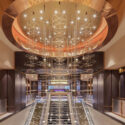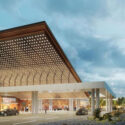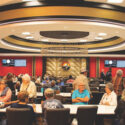
Despite the fact that the casino industry came to a grinding halt for nearly three months due to the Covid-19 crisis, many casino-hotel design, construction and expansion projects soldiered on. Consequently, the vendors that supply those projects have had to adjust their game plans to deal with the new normal forced by the pandemic.
The pandemic has, in particular, affected the nuts and bolts of casino design, which is the FF&E plan—furniture, fixtures and equipment.
The fundamentals, of course, remain the same. “The main criterion for FF&E is really just going to be function,” says Carl Long, senior vice president of Purchasing Management International (PMI), one of the companies charged with gathering and managing FF&E for a number of large projects, including the new Circa in Downtown Las Vegas. “The furnishings in a casino environment are used and abused, and heavily used. So, you need to go with reputable manufacturers. You need to be able to stand up to the rigors of a casino environment.”
That applies to each individual part of the FF&E plan, down to the chairs in which the players will sit. “First and foremost is comfort,” says Joe Esposito, CEO of furniture supplier Gary Platt Manufacturing. “At Gary Platt, we have spent years researching player habits, and we have found that when players are comfortable, they stay and enjoy the game longer. That’s why we developed our proprietary blend of foam that operators and players worldwide consider to be the most comfortable in, sit test after sit test… Our design team is filled with experts who also employ the latest developments in ergonomics in every chair model they create.”
‘Theater of Clean’
But in what is increasingly being identified as the Covid-19 era, ergonomic considerations are necessarily blended with the need for furniture to be cleaned and sanitized regularly.
“Pre-Covid, everybody was just trying to get more excitement,” says Long. “We’re working on the Circa in Downtown Las Vegas. It was the first new-construction hotel or casino in Downtown Las Vegas, and that’s a big deal, given the focus, but that was pre-Covid; that was the new thing. It was exciting, and people want to be part of what’s new.
“And now, post-Covid, people want to be part of what’s clean. And so, we’ve started talking a lot around here about the ‘theater of clean.’ How do you communicate about your gaming facility, your slot chairs, your gaming chairs, your gaming tables—how are you clean? And how are you protecting your employees, your customers? So, the trend on furnishings is using cleanable fabrics.”
One of the models being followed in this effort is the health care setting. “Those fabrics can basically withstand anything,” Long says, “and they’re anti-microbial—they actually don’t promote the growth of things in them, whereas other fabrics do. So, we’re seeing more and more of a trend toward that type of fabric. But what makes it difficult is they’re not as pretty. Think of a hospital. When you go to a hospital and sit in the waiting room, it’s not the glitziest-looking fabric.”
Long says one of the biggest challenges for furniture manufacturers is to combine anti-microbial fabrics with the classy look required for casino usage. “There are companies that do accept the challenge, and the interior designers will work towards getting that type of spec, looking at those manufacturers, to be able to meet those standards. So, those are questions that we ask our fabric companies. What fabrics do you use that are used in health care settings? Can you make that fabric in this style? Can you get that design?”
Long says senior living facilities provide another model for this combination in seating materials. “If you look at senior living, you’ll see a shift to more hospitality design, more comfortable design. They had started that, but it had never been used in casinos. It’s the durability that’s needed in a casino. The rough and tumble, we’re going to sit there, we’re going to spill a drink on it every 10 minutes. We’re going to to abuse it, 24/7.”
Manufacturers like Gary Platt are meeting this challenge, which in today’s environment goes along with catering to casino properties with significantly trimmed capital budgets.
“In today’s challenging environment, casinos want to be careful with their capital spend and ensure they are getting value for their money,” notes Esposito. “To that end, durability becomes more important every day, because casinos want their chairs to last long into the future.
“Of course, in the current pandemic, safety is paramount. We are partnering with fabric suppliers to recommend the safest, easiest-to-clean fabrics for casinos. In addition, we have developed cleaning protocol to share with our customers to ensure our chairs are also the safest on the market.”
Another area of casino design that is affecting FF&E in the Covid-19 era is the outdoor venue. As more casinos turn to outdoor amenities for a safer alternative during the pandemic, planning for these areas continues to evolve.

Lifescapes International has tailored the use of outdoor seating to Covid-19 distancing requirements
“With the impact on attendance at casino resorts due to Covid-19, design considerations have to include quantities of chaise lounges for the pool areas,” says Andrew Kreft, director of design for landscape architects Lifescapes International. “Reduction by 25-30 percent may be necessary for social distancing. However, if the need for outdoor patios at restaurants increases, there may be more attention spent on outdoor furniture, and also indoor furniture to accommodate customers that wish to be inside, but may require comfortable and socially distanced areas for small group interactions.”
These needs also may require rethinking the design of the chairs themselves. “Single chaise lounges that are light and stackable have always been important to allow for an easy transition to open up the decks for other uses in the off-season, but more and more operators prefer to have other seating configurations that can provide for tiered monetization,” says Kreft.
“Seating that holds two or even four people from the same social or family group on one larger chaise or bed allows for a tier of offerings above the single chaise, but below the full cabana. This opportunity will more than likely be even more advantageous with social distancing.”
2020 Reality
While there are projects like Circa, the Cordish Pennsylvania properties and others that have soldiered on through the Covid-19 shutdowns, this year’s new reality with respect to design projects and the furnishings at the heart of them all boils down to capital budgets.
Designers, FF&E planners and suppliers are dealing with budgets strained from consecutive zero-revenue months for the operators. The chain of this revenue strain travels to the contractors, suppliers and designers that depend on operators being able to wield those capital budgets.
“Long gone are the days of, ‘We’re going to make Revel,’ or ‘We’re going to build Borgata,’” says PMI’s Long. “The idea of working within a constrained budget to meet the goals is really at the forefront. Everybody right now is dealing with a mess of cash burn, but they still have to renovate. They still have to build.”
For FF&E aggregators like PMI, that means not only laying out plans to suit today’s budget, but providing backup plans to save money later. “We do a process called conceptual budgeting, where we work with the owner, work with the designer, and establish budget goals,” says Long. “We establish itemized budget allowances for everything on the project. It defines scope, it sets boundaries for the design team, and it lets the owner have a predictable anticipated cash flow. And you do that by being informed with current market prices, and changes in the supply chain.”
Long adds that keeping an eye on market prices can prevent surprises down the road, if the furniture purchase lags behind other elements of a design project. “If you didn’t plan for (the pricing) in the beginning, all of a sudden when you go to buy it you’re stuck, and you can’t actually afford it,” he says. “If the designer designed something that was out of your budget, you’ve wasted time on design. So, really collaborating early on in the process for budget guidance, and for schedule guidance, is critical, because with the starts and stops we’ve seen, and with some of the trade uncertainty that exists in our market currently, things take longer. Component parts take longer to find.”
Along with that goes a bit of future-proofing of the supply, so operators can be nimble when replacements are required. According to Long, the larger operators maintain an inventory of replacement chairs allowing quick on-site change-outs that minimize machine downtime.
Lifescapes’ Kreft says one key to surviving this year has been a constant effort to adapt to the new needs brought on not only by restrained budgets, but by the pandemic itself.
“This (effort) is ongoing, and our designers are constantly educating themselves about new products and technologies,” Kreft says. “We often bring in vendor representatives for ‘lunch and learn’ seminars to gain more insight into the uses of their products.”

Gary Platt Lugano
“Innovation is key to our success, and our design is constantly in a state of renewal,” says Esposito at Gary Platt. “As design tastes change and evolve, Gary Platt’s design team is perpetually changing and improving our line of chairs. We introduce several new models every year to our mix. Our greatest strength is our ability to adapt to changing market conditions, design trends, and casino requests, and still carefully handcraft the most comfortable, durable chairs on the market.
“Customization will continue to be a crucial aspect of the business. As casinos become more careful with their spends in today’s challenging environment, they want value and differentiation to separate them from their competition. Gary Platt will continue to work directly with each casino to develop the best solution for their future.”
Kreft says the coming months are likely to see a continuation of close attention to cost as operators carefully resume capital expenditures for property improvements, including new furnishings. “With cost considerations at the forefront of the market, we foresee a very cautious approach to purchasing any FF&E for existing projects unless it pertains to design changes resulting from the effects of the Covid-19 pandemic,” Kreft says.
“For new projects, there will be further discussions about the type of furnishings and space planning required for customers still concerned about the pandemic and its psychological and physical implications on their customers.
“Outdoor furniture design itself will have to come under scrutiny to see how its material makeup and design can be cleaned and disinfected easily, if not inhibit germs, between guests. Common use items like waste/recycling containers, towels bins, etc., will also need to transition to a touchless arrangement with automatically closing covers so guests do not have to come in contact with doors.”
PMI’s Long adds that the pandemic, and the need to return to full operations safely, will actually have a positive effect on the overall future of the industry. “It’s going to drive the older facilities to need to renovate,” he says. “Whether or not the current owners can do that remains to be seen. But that will create opportunity for either acquisition or reuse by another operator or owner.
“The arrangement of the product—meaning the gaming floor and F&B venues—will change. But it’s going to come back on an individual, drivable place. Where we see the biggest challenge is going to be conventions. And the large convention center facilities, where you have to have 8,000 or 10,000 people come through to make it work, those are going to take a little bit longer. Because you can’t get through those volumes of people presently. People are anxious.
“That is really going to drive, operationally, how a hotel, how a casino interacts with their guest. Make them feel safe, make them feel clean. Make it obvious that it’s clean. And translating that into furnishings, is it cleanable? Can it stand up to chemicals? Can it stand up to a deeper scrub than normal? Will a metal finish wear off?”
It’s all addressed at the beginning of each project, and the key to success is finding the right vendors to address each element, right down to how comfortable a chair is.
“We help players feel comfortable in the casino, whether that’s at the slot or the table,” says Gary Platt’s Esposito. “That may sound simplistic; however, it is perhaps the most important service we provide. The research is very clear that when players are comfortable, they play longer. That makes what we do at Gary Platt extremely important.
“Operators rely on us to help them increase their bottom line, and we take that responsibility seriously. We are continually researching new developments in design and ergonomics that help players feel comfortable wherever they decide to play.”
“As landscape architects, we are focused on guest experience on the exterior as well as interior environments,” says Kreft at Lifescapes International. “Restaurants will continue to expand their space to exterior patios largely to accommodate social distancing and to provide a sense of comfort and safety to customers.
“These spaces not only help guests feel more relaxed, they create unique and special environments which are appreciated by casino customers/visitors. It is also important that we consider creating flexible-use areas that can be used for pool, entertainment and food/beverage so that spaces can be easily put to a new use depending on the time of day, season or social distancing need.”
PMI’s Long sees a light at the end of the pandemic tunnel. “I think that the gaming side is going to come back strong, because people want to do stuff; people are tired of being cooped up,” he says. “And so the gaming operators that are able to space correctly, use the theater of clean, and actually have new product—they’re going to be attractive.”

















